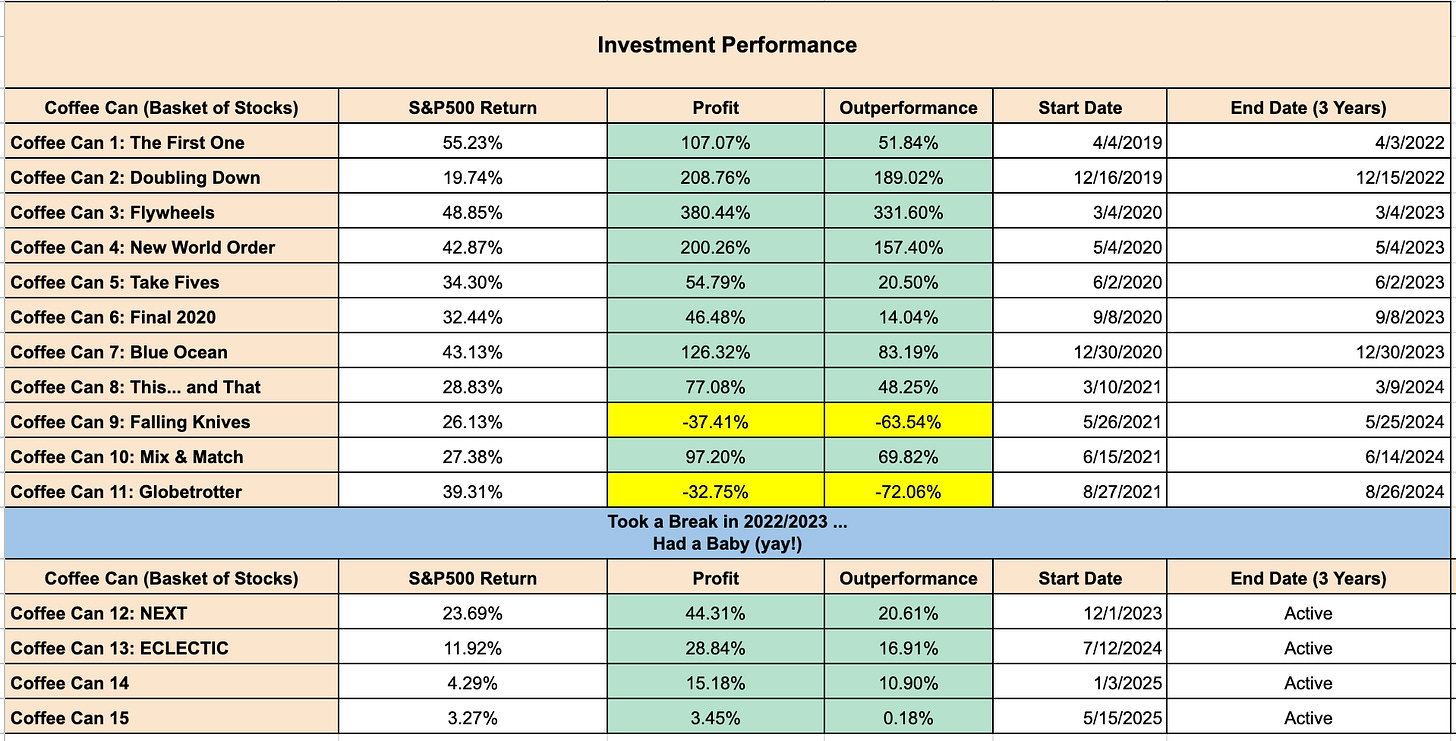Clarity vs Uncertainty: A Lesson From The Tariff Trade
If you like this article, please do share it with a friend & click the ❤️ above. Thanks :)
Here is the performance of our current active portfolios (zoom in):
If you’re new here, I share “buy-and-hold portfolios” that can double in 3-5 years. Our investment philosophy is simple: Try to find the best stocks you can and let them sit for years. Incur no costs with such a portfolio, and it is simple to manage.
Playing For Doubles Alerts
I’ve been sending free same-day notifications of my buys/sells to folks on the Playing For Doubles Alerts Waitlist.
For those who’ve signed up, I hope you’ve benefited from this. I especially hope it was helpful to see how we built Portfolio 14 during the high-volatility drawdown period following the tariff announcements on April 2.
If you’re interested in receiving these alerts, join the waitlist here.
Lessons From The Tariff Trade
On April 1, ironically April Fool’s Day, I wrote that “the market could rally post tariff announcements due to the resolution of tariff uncertainty, even if tariffs are higher than expected.”
Well, the tariff announcement didn't create clarity, it created chaos. The S&P 500 plunged 5% on April 2nd, wiping out $2.4 trillion in a single day.
My core assumption was flawed. I assumed Trump's announcement would provide clarity. Instead, Trump announced Washington's steepest trade barriers in more than 100 years.
Let's analyze what happened, and what we can do differently in the future.
First…did anything go right?
Yes, we successfully identified a major catalyst that created significant price movement.
That’s half the battle.
Remember that when we bet on catalysts, it is like stepping up to the plate and taking a big swing. Even though we may often strike out, we're also bound to hit some home runs. That’s exactly what the venture capital mindset is all about.
This quote from Jeff Bezos describes it perfectly:
“We all know that if you swing for the fences, you’re going to strike out a lot, but you’re also going to hit some home runs. The difference between baseball and business, however, is that baseball has a truncated outcome distribution. When you swing, no matter how well you connect with the ball, the most runs you can get is four.
In business, every once in a while, when you step up to the plate, you can score 1,000 runs.”
-Jeff Bezos, Founder, Amazon
Unfortunately, we didn’t score a 1000 runs this time around.
What went wrong?
Price Direction:
The magnitude of the announcement completely overwhelmed the "uncertainty discount". The size and scope of the tariffs announced exceeded even some of the most bearish forecasts. As a result stocks went down, not up.
Our Mental Model was Incomplete:
I underestimated how quickly "clarity" can become "new uncertainty".
My mental model was wrong.
I thought markets don’t like uncertainty. This is true. But when bad news is this bad, markets don’t prefer bad news to uncertainty.
The Reality Check
On April 1, under the section Strategy Considerations in my article, I wrote
“Risk Management: Of course, the above hypothesis could be completely wrong. So managing risk via an appropriate bet size is paramount.”
Considering the very asymmetric nature of this bet, there is no need to bet more than say 1-2% of the portfolio (at the high end).
As a result, the portfolio outcome, even though it was negative, was not catastrophic by any means.
If I had a do-over, would I do anything differently?
In my mind, there are 2 way to approach such a decision:
Approach 1: Do nothing differently.
We know that we are swinging for the fences with such bets. It’s natural, even expected, that most of these bets will fail. Therefore, what’s important then is to ensure we don’t damage the portfolio catastrophically if wrong. We can do that simply by controlling our bet size.
Approach 2: Ask “what if I’m wrong?”
If I’m wrong about the catalyst, ask would that create a significant price movement in the opposite direction (like in the case of the Tariff announcements). If yes, then I’d consider hedging my bet.
For example, our Tariff trade bet was to purchase calls expiring in say a week or two in the future, but we could also marry those with some Puts expiring at the same time.
Like any hedge, this would create performance drag. But in a situation where the catalyst is so significant, perhaps a small hedge is worth it. Plus if we’re right about the magnitude of the catalyst, the minor performance drag likely won’t matter (much).
Bottom Line Conclusion
The April 2025 tariff trade was supposed to validate the idea that markets prefer bad news to uncertainty. Instead, it taught us that some news is so bad it creates more uncertainty than it resolves.
When Trump became president, the expectations were that we were getting an administration that was very pro business. Instead we got policies that were extremely bad for business. The state of the economic world got radically changed. Most investors thought for the worst, and as a result, equity prices went down sharply.
But here's the silver lining: The framework wasn't entirely wrong, just incomplete.
The relief rally did happen—it just required an actual policy reversal rather than policy announcement. The Nasdaq closed up 12% in the biggest one-day percentage gain since 2001 when Trump backed down and announced a 90 day pause.
If you liked this article, please do share it with a friend & click the ❤️ . Thanks :)





